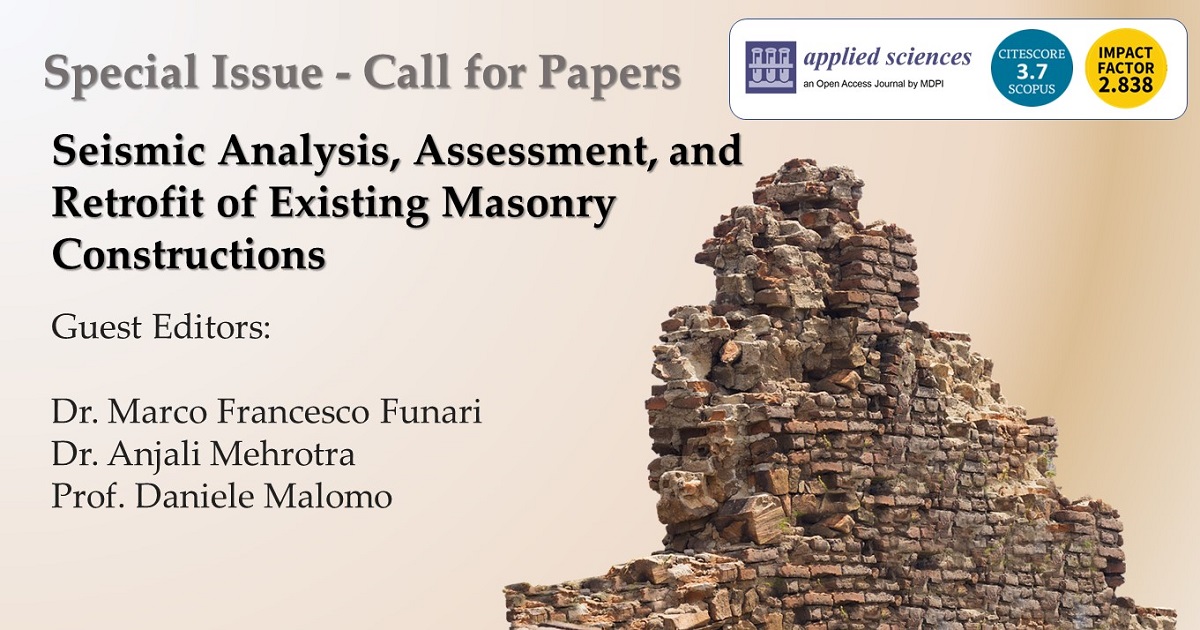- 2.5Impact Factor
- 5.5CiteScore
- 20 daysTime to First Decision
Seismic Analysis, Assessment, and Retrofit of Existing Masonry Constructions
This special issue belongs to the section “Civil Engineering“.
Special Issue Information
Dear Colleagues,
A considerable portion of the built environment is made of masonry. This includes both historical and modern structures erected using a number of different construction techniques and materials. Because of their longevity and the legacy they represent to the general public, masonry constructions (MC) are often imbued with significant historic and cultural value.
Nonetheless, MCs are susceptible to the effects of climate change, and are particularly vulnerable to a variety of different hazards and loading conditions, including wind, floods, and impacts from blasts and other impulsive loads. However, the main cause of damage to MCs is still earthquakes, historically responsible for relevant socio-economic losses in several regions all over the world, which are also steadily increasing as a result of induced seismicity phenomena.
Impressive advancements have been made in the last decade to investigate, assess, and improve the seismic response of MCs. Recent technological developments have enabled researchers to develop numerical and analytical models of increasing complexity, whose interaction with new digital representation and acquisition tools present new perspectives and challenges.
In this Special Issue, focused on the seismic analysis, assessment, and retrofit of existing masonry constructions, original research papers, case studies, and state-of-the-art reviews from both researchers and practitioners are welcome. Covered topics may include the application and development of numerical and analytical modelling strategies, risk assessment modelling, lessons learnt from post-earthquake observations and surveys, seismic retrofitting systems, experimental testing, in-situ material characterization, and insights from structural health monitoring activities.
We hope that this Special Issue will provide the scientific community with a thorough overview of the current research on this topic, while providing valuable insight for future research directions.
Dr. Marco Francesco Funari
Dr. Anjali Mehrotra
Dr. Daniele Malomo
Guest Editors
Manuscript Submission Information
Manuscripts should be submitted online at www.mdpi.com by registering and logging in to this website. Once you are registered, click here to go to the submission form. Manuscripts can be submitted until the deadline. All submissions that pass pre-check are peer-reviewed. Accepted papers will be published continuously in the journal (as soon as accepted) and will be listed together on the special issue website. Research articles, review articles as well as short communications are invited. For planned papers, a title and short abstract (about 250 words) can be sent to the Editorial Office for assessment.
Submitted manuscripts should not have been published previously, nor be under consideration for publication elsewhere (except conference proceedings papers). All manuscripts are thoroughly refereed through a single-blind peer-review process. A guide for authors and other relevant information for submission of manuscripts is available on the Instructions for Authors page. Applied Sciences is an international peer-reviewed open access semimonthly journal published by MDPI.
Please visit the Instructions for Authors page before submitting a manuscript. The Article Processing Charge (APC) for publication in this open access journal is 2400 CHF (Swiss Francs). Submitted papers should be well formatted and use good English. Authors may use MDPI's English editing service prior to publication or during author revisions.
Keywords
- masonry
- numerical modelling
- analytical methods
- risk assessment
- post-earthquake observations and surveys
- experimental testing
- seismic retrofitting
- in-situ material characterization

Benefits of Publishing in a Special Issue
- Ease of navigation: Grouping papers by topic helps scholars navigate broad scope journals more efficiently.
- Greater discoverability: Special Issues support the reach and impact of scientific research. Articles in Special Issues are more discoverable and cited more frequently.
- Expansion of research network: Special Issues facilitate connections among authors, fostering scientific collaborations.
- External promotion: Articles in Special Issues are often promoted through the journal's social media, increasing their visibility.
- e-Book format: Special Issues with more than 10 articles can be published as dedicated e-books, ensuring wide and rapid dissemination.

